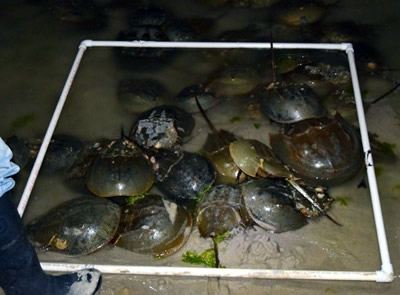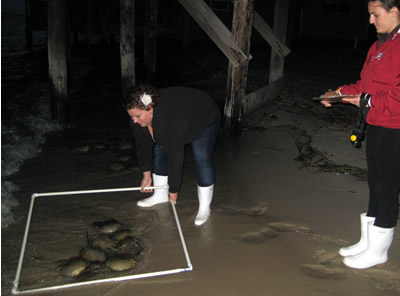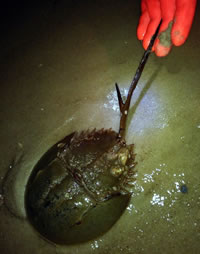by Rebecca Buteau, Hourly Fisheries Technician
NOTE: This article is one in the series, A Day In the Life Of a Marine Fisheries Hourly.
Horseshoe crabs originated over 450 million years ago (much earlier than dinosaurs!). Although they are called crabs, they are more closely related to spiders and scorpions. There are four living species of horseshoe crabs and the species studied in this survey is the Atlantic Horseshoe Crab (Limulus polyphemus). Each year, around the new and full moons of May and June, the Bureau of Marine Fisheries conducts a horseshoe crab survey at Fortescue Beach and Gandy's Beach on Delaware Bay (see the Beach Closure Map for beach locations). This survey involves heading out to the beach late at night and counting thousands and thousands of horseshoe crabs into the wee hours of the morning with a head lamp and two 1m x 1m PVC quadrats. For this survey, we leave the lab sometime between 7:00 p.m. and 10:00 p.m., depending on the tide schedule. We arrive at the lab about 15 minutes early to get all the gear ready to go and in the truck. This includes: PVC quadrats, headlamps, survey instructions, data sheets, and weather protective clothing. We make sure to bring boots or waders because we will be walking along the shore through water that may come up to our knees. Once we get to Fortescue, we drive to a randomly determined end of the beach to begin the survey. The first step is to gear-up: we don our boots or waders, warm jackets, and headlamps to help us see in the dark. We then begin recording information about the weather (amount of light and cloud cover), wave height, and survey start time. Next, we head onto the beach where we can already see hundreds of horseshoe crabs littering the shoreline. To begin counting we use two randomly determined locations as starting points for each quadrat and lay the quadrats down on the ground and begin counting all the horseshoe crabs that fall within them. We then measure out 15 meters and use the quadrats to count all the horseshoe crabs in that next location. The process is repeated until we reach the opposite end of the beach.
Males and females are recorded separately and special note is taken of any tagged horseshoe crabs. Once we finish sampling at Fortescue Beach we then drive to Gandy's Beach to sample. Gandy's Beach has a much smaller survey area, so instead of stopping to count every 15 meters, we use only one quadrat and stop to count the horseshoe crabs within each consecutive quadrat.
Horseshoe crabs are an interesting species with 10 eyes, and legs attached at the mouth. It is estimated that a single breeding female lays up to 90,000 eggs in one season. These eggs measure 3-3.7 millimeters (half the size of a grain of rice) in diameter. With the Delaware Bay being the world's largest spawning ground for horseshoe crabs, this survey is very important in determining the population level and dynamics of the species. One might be wondering why horseshoe crabs even matter at all, but the species is actually highly useful and valuable for many reasons and to many other species. During their time in the Delaware Bay area, at least 11 species of migratory birds use horseshoe crab eggs as a primary food source to help replenish their fat supply on their northward journey. Most of these eggs are from nests disturbed by waves and storms, and the feeding of the shorebirds does not appear to have a negative effect on horseshoe crab breeding success. Several species of ocean dwelling species including striped bass, white perch, American eel, killifish, silver perch, weakfish, kingfish, silversides, flounder, crabs, gastropods, and sea turtles also eat horseshoe crab eggs and larvae.
Taking all this into account, the horseshoe crab survey becomes very important. The data generated can aid in determining annual harvest quotas for bait fisheries and LAL testing that still allow for viable populations of horseshoe crabs. People can also do their part to help horseshoe crab populations through a very simple act: whenever a horseshoe crab is found stranded upside down on the beach, take the time to stop and flip it back over. The best way to do this is by the edge of their shells so as not to damage their tails. Horseshoe crabs don't bite or sting so they are harmless to people who help them out. Helping to ensure the long-term survival of this species is important to people and many species of fish and wildlife. Knowing this makes the long, cold, pre-daylight sampling much less daunting and we look forward to seeing how many horseshoe crabs we count next year. |
|||||||||||
|
||
|
|
||
|
||
| |
||




